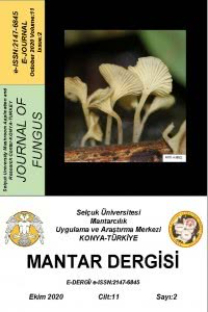Detect on of Fung n Cool ng Tower Samples Us ng Fluorescent In S tu Hybr d zat on and Trad t onal Culture- Dependent Methods
Floresanlı Yerinde Hibritleme v_e Geleneksel Kültür Yöntemlerini Kullanılarak Soğutma Kulesi Orneklerinde Fungusların Tespiti
___
Amann, R.|., Fuchs, B., Behrens, S., The Identification of Microorganisms by Fluorescence in Situ Hybridisation, Current opnion in Biotechnology, 12(3): 231—236 (2001 ).Amann, R.|., Ludwig, W., Schleifer. K.H., Phylogenetic identification and in Situ Detection of Individual Microbial Cells without Cultivation. Microbiological Reviews. 59: 143-169 (1995).
Arvanitidou, M., Kanellou, K., Constantinides, T.C., Katsouyannopoulos, V., The Occurrence of Fungi in Hospital and Community Potable Waters, Letters in Applied Microbiology, 29: 81-84 (1999).
Asan, A., Ekmekçi, S., Contribution to the Colonical and Morphological Characteristics of Some Aspergillus Species Isolated from Soil, Ege University Journal of The Faculty of Science, 25(1 ): 121-139 (2002).
Asan, A., Krrgrz, T., Şen, B., Çamur—Elipek, B., Güner, U., Güher, H. :lsolation, Identification and seasonal distribution of airborne and waterborne fungi in Terkos lake (istanbul-Turkey), Journal of Basic Microbiology, 43(2): 83-95 (2003).
Asan, A., ilhan, S., Şen, B., Potoğlu Erkara, İ., Filik, C., Çabuk, A., Demirel, R., Türe, M., Sarıca Ökten, S., Tokur, S.,: Airborne Fungi and Actinomycetes Concentrations in the Air of Eskişehir City (Turkey), Indoor and Built Environment, 13: 63-74 (2004).
Baker, B.J., Lutz, M.A., Dawson, S.C., Bond, P.L., Banfield, J.F., MetabolicallyActive Eukaryotic Communities in ExtremelyAcidic Mine Drainage, 70(10): 6264-6271 (2004).
Baschien, C., Manz, W., Neu,T.R., Marvanova', L., Szewzyk, U., In Situ Detection of Freshwater Fungi in an
Alpine Stream by New Taxon-Specific Fluorescence In Situ Hybridization Probes, Applied and Cooling tower Microbiology, 74(20): 6427-6436 (2008).
Choudhary, S.G., Emerging Microbial Control Issues in Cooling Water Systems. Hydrocarbon Processing, 77(5): 91-102 (1998).
Demirel, R., Ilhan, S., Asan, A., Kınacı, E., Oner, S., Microfungi in Cultivated Fields in Eskişehir Provience (Turkey), Journal of Basic Microbiology, 45(4): 279-293 (2005).
Domingos Arantes, T., Cordeiro Theodoro R., de Melo Teixeira, M., Bagagli, E., Use of Fluorescent Oligonucleotide Probes for Differentiation between Paracoccidioides brasiliensis and Paracoccidioides Iutzii in Yeast and Mycelial Phase, The Memörias do Instituto Oswaldo Cruz, Rio de Janeiro, 112(2): 140-145 (2017). 74
MANTAR DERGİSİ/The Journal of Fungus Nisan(201 7)8( 1) 68- 75 Ellis, M.B., Dematiaceous Hyphomycetes, The Eastern Press, London, UK, (1971). Gagnon, G.A., SIawson, R,M., An Efficient Biofilm Removal Method for Bacterial Cells Exposed to Drinking Water, Journal of Microbiological Methods, 34(3): 203- 214 (1999).
Göksay Kadaifciler, D., Demirel, R., Fungal Biodiversity and Mycotoxigenic Fungi in Cooling—Tower Water Systems in Istanbul, Turkey, DOI: 10.2166/wh.2017.274 (2017).
Guarro, J., Gene, J., Stchigel, A., Developments in Fungal Taxonomy, Clinical Microbiology Reviews, 12(3): 454- 500 (1999). H.L. Barnett, B.B. Hunter, Illustrated genera of imperfect fungi, APS Press, St. Paul-Minnesota, USA, 1999.
Ilhan, S., Demirel, R., Asan, A., Bayçu, G., Kınacı, E., Colonial and Morphological Characteristics of Some Microfungal Species Isolated from Agricultural Soils in Eskişehir Province (Turkey), 30: 95-104 (2006).
Jobard, M., Rasconi, S., Sime-Ngando, T., Fluorescence in Situ Hybridization of Uncultured Zoosporic Fungi: Testing With Clone-FISH and Application to Freshwater Samples using CARD-FISH, Journal of
Microbiological Methods, 83: 236-243 (2010). Kantarcıoğlu, A. S., Yücel, A., Aspergillus Cinsi Mantarlar ve İnvazivAspergi/Ioz: Mikoloji, Patogenez, Laboratuvar Tanımı, Antifungallere Direnç ve Duyarlılık Deneyleri, Cerrahpaşa Tıp Dergisi, 34(3): 140-145 (2003).
Kasapgil İnce, B., Usenti, |., Eyigor, A., Ayman Oz, N., Kolukirik, M., Ince, O., Analysis of Methanogenic Archaeal and Sulphate Reducing Bacterial Populations in Deep Sediments of the Black Sea, Geomicrobiology Journal, 23: 285—292 (2006).
Klich, M.A., Identification of common Aspergillus species, Centraalbureau voor Schimmelcultures, Utrecht, Netherlands, (2002).
Li, S., Spear, R.N., Andrews, J.H., Quantitative Fluorescence in Situ Hybridization of Aureobasidium pullulans on
Microscope Slides and Leaf Surfaces, Applied and Cooling tower Microbiology, 63(8): 3261-3267 (1997).
Lischewsk, A., Amann, R.|., Harmsen, D., Merkert, H., Hacker, J., Morschhauser, J., Specific Detection of Candida albicans and Candida tropicalis by Fluorescent İn Situ Hybridization With an 18S rRNA-Targeted Oligonucleotide Probe, Microbiology, 142: 2731-2740 (1996).
Moter, A., Göbel, U.B., Fluorescence in Situ Hybridization (FISH) for Direct Visualization of Microorganisms,
Journal of Microbiological Methods, 1: 85-11 (2000). Öner, M., Mikoloji I, Myxomycetes, Phycomycetes, Ascomycetes, 4. Baskı. Ege Üniversitesi Fen Fakültesi Kitaplar
Serisi no 53. Ege Üniversitesi Basımevi, Bornova, İzmir. (1998). Sime, A.D., Abbott, L.L., Abbott, S.P., Mounting Medium for Use in İndoorAir Ouality Spore-Trap Analyses,
Mycologia., 94: 1087-1088 (2002). Spear, R.N., Li, S., Nordheim, E.V., Andrews, J.H., Quantitative imaging and StatisticalAna/ysis of Fluorescence
Hybridization (FISH) ofAureobasidium pullulans, Journal of Microbiological Methods 35: 101—110 (1999).
Szymanska, J., Evaluation of Mycological Contamination of Dental Unit Waterlines, Annals of Agricultural and Cooling tower Medicine, 2: 53—1 55 (2005).
Yazıcıoğlu, M., Asan, A., Ones, U., Vatansever, U., Şen, B., Ture, M., Bostancıoğlu, M., Pala, O.: IndoorAirborne
Fungal Spores and Home Characteristics in Asthmatic Children from Edirne Region of Turkey, Allergologia et Immunopathologia, 32(4): 197-203 (2004)
- ISSN: 2147-6845
- Yayın Aralığı: 2
- Başlangıç: 2010
- Yayıncı: Selçuk Üniversitesi Mantarcılık Uygulama ve Araştırma Merkezi Müdürlüğü
Infundibulicybe alkaliviolascens (Tricholomataceae): Türkiye Mikotası için Yeni Bir Kayıt
Ertuğrul SESLİ, Ayşegül TOPCU SESLI
Aydın İl nde Termof l k Çevreden İzole Ed len Mayaların Moleküler Tanısı
H. Halil BIYIK, Esin Poyrazoğlu ÇOBAN, Yusuf GEROĞLU, Ilgıt KIRGIZ
Türkiye Hyaloscyphaceae’lerine Yeni İlaveler
Yasin UZUN, Abdullah KAYA, İbrahim Halil KARACAN, Semiha YAKAR
Duygu Kadaifçiler, Zuhal Zeybek
Nallıhan (Ankara) İlçesi Makrofungusları
CELALEDDİN ÖZTÜRK, Dilek PAMUKÇU, SİNAN AKTAŞ
Aydın İlinde Termofilik Çevreden İzole Edilen Mayaların Moleküler Tanısı
H. Halil BIYIK, Esin POYRAZOĞLU ÇOBAN, Yusuf GEROĞLU, İlgıt KIRGIZ
Duygu GÖKSAY KADAİFÇİLER, ZUHAL ZEYBEK
New add t ons to Turk sh Hyaloscyphaceae
Yasin UZUN, ABDULLAH KAYA, İbrahim Halil KARACAN, Semiha YAKAR
Türkiye'de Artemisia Üyeleri Üzerinde Belirlenen Puccinia (Pucciniales) Türleri
Sanli Kabaktepe, MURAT KURŞAT, ILGAZ AKATA, ŞEMSETTİN CİVELEK
Çay Üretim Aşamalarından İzole Edilen Mayaların Tanımlanması
ELİF SEVİM, ALİ SEVİM, Hacer TAŞKIRAN GENÇ, ŞENGÜL ALPAY KARAOĞLU
